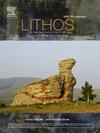Coupled U-Pb, Lu-Hf and trace element geochemistry of apatite reveals complex magmatic-hydrothermal Nb-REE remobilization of the Neoproterozoic Saint-Honoré carbonatite deposit (Quebec, Canada)
IF 2.9
2区 地球科学
Q2 GEOCHEMISTRY & GEOPHYSICS
引用次数: 0
Abstract
Niobium and REE are critical resources that are predominantly associated with carbonatite and alkaline complexes. The Saint-Honoré ore deposit, located in Québec, is a major producer of Nb (7 % of world production) with reserves of 630 thousand tons Nb and major REE resources (1058 thousand tons inferred). This deposit is composed of an outer syenite, inner syenite enclaves, multiple Nb-rich carbonatite intrusions and, a central REE-rich carbonatite. The carbonatites exhibit several generations of apatite (Ca5(PO4)3(F,OH,Cl)) including a magmatic ‘white’ apatite associated with pyrochlore ((Na,Ca)2Nb2O6(OH,F)) and a late hydrothermal ‘red’ apatite. Trace element geochemistry of apatite reveals a very distinct chemistry for both apatite types. The magmatic carbonatite stage is associated with the main Nb mineralization and is dated at 577 ± 14 Ma (U-Pb) and 580 ± 13 Ma (Lu-Hf), with a typical magmatic carbonatite signature whereas the hydrothermal stage has a mixed signature between carbonatite and external fluids which remobilized Nb-(REE) mineralization at 564 ± 16 Ma (Lu-Hf). While the magmatic and hydrothermal stage ages overlap and are also coeval to our lamprophyre apatite age of 569 ± 29 Ma (U-Pb), the late hydrothermal stage is distinctively marked by higher U, Cl, Ba, Fe, Nb and K concentrations in apatite. The late hydrothermal event is linked to a carbonatite fluid mixed with crustal fluids which may have contributed to the emplacement of the REE mineralization in the late stage of the carbonatite complex. This study also highlights the first detailed data on apatite geochemistry from lamprophyre.
磷灰石U-Pb、Lu-Hf和微量元素地球化学耦合揭示了加拿大魁北克新元古代saint - honor碳酸盐岩矿床岩浆-热液Nb-REE复合再活化作用
铌和稀土是主要与碳酸盐岩和碱性配合物伴生的关键资源。saint - honor矿床位于qusamubec,是铌的主要产地(占世界产量的7%),储量为63万吨铌和主要稀土资源(推断为105.8万吨)。矿床由外正长岩、内正长岩包体、多个富铌碳酸岩侵入体和中心富稀土碳酸岩组成。碳酸盐岩显示出几代磷灰石(Ca5(PO4)3(F,OH,Cl)),包括岩浆“白色”磷灰石与焦绿石((Na,Ca)2Nb2O6(OH,F))和晚期热液“红色”磷灰石。磷灰石的微量元素地球化学表明两种磷灰石类型具有非常不同的化学性质。岩浆碳酸盐岩阶段与主要的铌成矿作用有关,其定年为577±14 Ma (U-Pb)和580±13 Ma (Lu-Hf),具有典型的岩浆碳酸盐岩特征;热液阶段为碳酸盐岩和外部流体混合特征,在564±16 Ma (Lu-Hf)重新活化了铌(REE)成矿作用。岩浆期和热液期年龄重叠,且与煌斑岩磷灰石年龄(569±29 Ma (U- pb))一致,但热液期晚期磷灰石中U、Cl、Ba、Fe、Nb和K的含量较高。晚期热液事件与碳酸盐岩流体与地壳流体的混合有关,这可能是碳酸盐岩杂岩晚期稀土矿化侵位的重要原因。该研究还首次获得了煌斑岩磷灰石地球化学的详细数据。
本文章由计算机程序翻译,如有差异,请以英文原文为准。
求助全文
约1分钟内获得全文
求助全文
来源期刊

Lithos
地学-地球化学与地球物理
CiteScore
6.80
自引率
11.40%
发文量
286
审稿时长
3.5 months
期刊介绍:
Lithos publishes original research papers on the petrology, geochemistry and petrogenesis of igneous and metamorphic rocks. Papers on mineralogy/mineral physics related to petrology and petrogenetic problems are also welcomed.
 求助内容:
求助内容: 应助结果提醒方式:
应助结果提醒方式:


